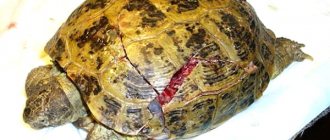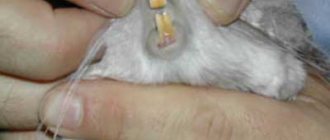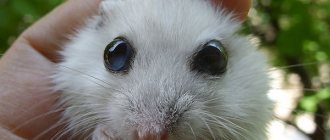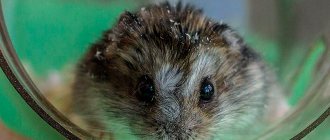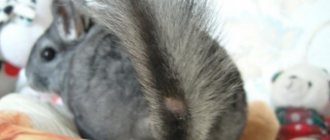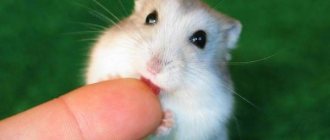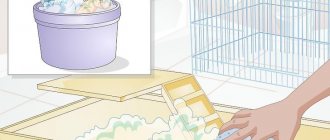- home
- Chinchilla
- Health
04/14/2019 Eye diseases are not considered common diseases in chinchillas. Nevertheless, it still happens to notice pus in the eyes of your beloved pet. This phenomenon can only mean one thing - there is an infection. What to do?
Chinchillas have a strong immune system, so eye inflammation requires immediate action. You should begin as soon as possible to find out the cause of the disease, its elimination and treatment.
Causes of purulent discharge from the eyes
The most common cause of purulent discharge is conjunctivitis. This is one of the most common eye diseases that can affect not only chinchillas, but also pets in general. During this disease, inflammation of the conjunctiva (mucous membrane of the eyes) occurs, symptomatically this is manifested by swelling of the mucous membrane, lacrimation, souring and suppuration.
In most cases, conjunctivitis occurs due to unsanitary conditions for keeping chinchillas (dirty bedding or cage). But there may also be other reasons. For example, purulent discharge from the eyes may be due to a cold or viral infection. In this case, the root cause of poor health should be eliminated. This is especially dangerous, because a cold in a chinchilla can quickly develop into bronchopneumonia. Pay attention to any difficulty breathing or wheezing. Another fairly common culprit of this chinchilla disease is the damaged cornea of the chinchilla's eye. Sometimes dripping eyes can also be a symptom of a very serious condition caused by a malocclusion, hooks, or tooth root growing into the tear duct or eyeball. In this case, surgery is necessary.
Eye diseases and methods of their treatment
Diseases can be identified by visual examination and first aid provided. Immediately you need to rinse the animal’s eyes with warm boiled water using cotton pads or gauze swabs. The corners are softened and dried secretions are removed. The eyelids are carefully spread with your fingers and the mucous membrane is examined so that there are no foreign bodies on it. If any deposits are found, they must be carefully removed. It is allowed to use drops that relieve inflammation as prescribed by a veterinarian.
Video: How to put drops into the eyes of a chinchilla
Conjunctivitis
Conjunctivitis is an inflammation of the mucous membrane of the organs of vision, accompanied by lacrimation and suppuration.
Associated symptoms appear:
- swelling of the eyelids;
- photophobia;
- pus collects in the corners;
- reddened eyelid skin.
Important! After first aid, you must immediately transport the rodent to a veterinary clinic. The specialist will prescribe antibacterial drugs that may solve the problem.
The disease occurs as a result of injuries, falls, or during planting of individuals, exposure to smoke or dust on the mucous membrane, or unsanitary conditions in the cage. Complications may arise as a result of which the eye stops opening altogether. Initially, you need to find the cause - this will help you choose the right course of therapy. If left untreated, ulcers may form on the cornea and the animal may go blind.
Dried purulent accumulations should be removed with a damp cotton swab. Then rinse the eyes with a sterile saline solution of 3% boric acid, a decoction of black tea or chamomile. The cage needs to be cleaned and disinfected.
Cataract
A cataract is a clouding of the lens of the eye that reduces the ability to transmit light. The disease can affect the organ either partially or completely. The bottom line is that a healthy lens is completely transparent. Rays of light are refracted through it and directed to the retina of the organ of vision. When he is struck by cataracts, the pet partially loses his vision and sees the surrounding space as if through streams of water, which is why the name of the disease means “waterfall.”
Important! Cataracts are treated only under the strict supervision of a veterinarian. Unfortunately, with this disease the rodent often loses its vision.
The most common reasons why this disease develops are the following:
- pathologies of the organs of vision;
- impaired metabolism;
- avitaminosis;
- mechanical damage;
- age;
- diabetes;
- heredity and congenital anomaly;
- radiation.
Keratitis
The cornea can become inflamed during mechanical damage, after an animal fight, grains of sand, or during bathing, which provokes keratitis.
Characteristic symptoms:
- unnatural eye color;
- cloudy red shell;
- purulent discharge;
- ulcers.
Find out also how much a chinchilla costs.
For treatment, purchase an ointment that contains antibiotics and fluorescein drops. The consequences of self-medication can cause the progression of a corneal ulcer, so it is necessary to consult a specialist.
Belmo
One of the pathologies of the visual organ, in which persistent clouding of the cornea is observed, is called a cataract.
Appears as a consequence:
- infectious disease;
- injury;
- complications of conjunctivitis.
A white spot appears on the cornea. If you delay in solving the problem, the animal may go blind. The cataract is incurable, so veterinarians have to perform surgery to remove it.
Pay attention to the information on how to properly care for chinchillas at home.
Inflammation and suppuration due to eye injury
In situations where the visual organ is injured, a white spot quickly (literally within a day) appears on the surface of the cornea, which is often confused with a cataract. Such damage occurs due to bruises or the impact of sand crumbs on the mucous membrane of the eye. It is necessary to use Taufon drops or Korneregel ointment.
Complex injuries are accompanied by suppuration and whitening of the iris, as well as inflammation of the eyelids, which causes infection. After preventive measures, you should definitely show the animal to a specialist.
Important! Most products intended for use on people and other pets are not suitable for chinchillas. Rodents have a different sensitivity to medications, so only a veterinarian can determine the correct remedy and dose.
Comprehensive treatment is carried out at home. First, Tetracycline ointment is applied for three days to relieve inflammation. For healing, Korneregel is used for five days. After this, the three-day procedure with Tetracycline is repeated again to treat relapses.
Do I need to rinse my eyes?
Of course it is necessary. Another question - with what?
Quite often, owners use decoctions of medicinal herbs to wash their pets - strong tea, chamomile or calendula decoction. Veterinarians do not advise doing this for a number of reasons: they dry out the mucous membrane, it is impossible to maintain the normal concentration of the solution, such decoctions quickly become unusable, becoming a source of secondary bacterial infection.
To wash the eyes of a chinchilla, it is advisable to use special lotions - Lakrimin, Lakrikan, Ofto-lavas.
In the absence of special means, you can wash your chinchilla’s eyes with simple freshly boiled and cooled water or sterile saline solution.
Cataract
One of the eye diseases common to both humans and animals is cataracts. A cataract is a clouding of the lens of the eye and a decrease in its ability to transmit light. The name “cataract” itself translates as “waterfall”. Even the ancients noted that with the development of cataracts, a person begins to see as if through water falling from above. Unfortunately, the causes of the development of this disease have not been studied even in humans, not to mention animals. One thing is certain - heredity plays a significant role in the occurrence of cataracts. You won’t be able to cope with cataracts in an animal yourself; you need timely and qualified help from a specialist.
In this regard, when purchasing a pet, be sure to inquire about the health of its parents; it is better if you can see the pet’s mother and father yourself. Individuals with cataracts are removed from reproduction.
Chinchilla eye drops
For eye inflammation, veterinarians usually prescribe special eye drops “Tsiprovet” or “human” drops “Tsipromed” sold in a regular pharmacy. Their effect is double: broad antibacterial and anti-inflammatory.
You can also use Iris or Tobrex drops. Application: for a diseased eye - 1-2 drops 3 times a day, for a healthy eye (as a mandatory prophylaxis) - 1 drop 1-2 times a day. Duration of treatment – 7 days. Also, in case of emergency, you can use 20% sodium sulfacyl solution, also known as Albucid or Levomycetin. However, remember that these drops cause a burning sensation. In addition, they only have an antibacterial effect.
In case of injury to the eyeball, it is recommended to use drops with taurine - this is a drug that accelerates tissue regeneration. Taurine-based drops – Taufon.
It is extremely important to properly store the opened bottle. Typically, the validity period of the drops after opening the bottle is 7 days. Store opened medicine in the refrigerator. Avoid touching the tip of the dropper - this will significantly reduce the shelf life of the medicine. Before using drops from the refrigerator, warm the bottle in your hand.
Diseases manifested by eye symptoms
Inflammation of the organs of vision in a rodent also signals infections and viral diseases. These include:
- Lichen (trichophytia, microsporia). The disease is contagious to humans. The pet's skin becomes covered with pathogenic fungi, hair begins to fall out on the limbs, around the nose and eyelids. Areas without hair of a clear round shape appear on the skin, which peel off. The examination should be carried out by a doctor using skin scraping. During treatment, be sure to take antifungal agents.
- Diseases of dentistry. Your pet may experience pathological ingrowth of teeth into soft tissue. Elongated roots affect the sinuses and eyes. As a result, discharge from the organs of vision, salivation occurs, and the rodent refuses food. The disease also occurs when the oral cavity is injured or due to an incorrect diet or genetic pathologies. They are treated under anesthesia in a veterinary clinic.
- Tick. Affects animals in rare cases. Infection can occur through food, human hands or litter. The rodent itches more often than usual and tears out the fur around the eyelids and ears, and the fur falls off on the neck and red wounds appear. Veterinarians prescribe insecticidal sprays that are used to treat the pet.
- Cold. When the conditions of detention are violated, the pet can simply catch a cold. There is swelling of the eyelids, runny nose, severe lacrimation, sneezing, rapid breathing, fever, and wheezing. They are treated under the supervision of a specialist.
- Allergy. The reaction may occur to food, cage fillers, or indoor plants. Accompanied by sneezing, mucus discharge from the eye sockets, body itching and the appearance of baldness. It is necessary to eliminate the allergen and conduct a course of therapy with antihistamines.
If you find any unnatural discharge from the organs of vision, redness, swollen eyelids, or hair loss, this may be evidence of a serious viral disease.
Did you know? Chinchillas do not have a specific odor because they do not have sweat glands. Because of this, the animals quickly get wet in the water and cannot stay on its surface.
Redness and itching in the eyes: what to do?
At the first signs of conjunctivitis, you should immediately consult an ophthalmologist. But the opportunity to visit a specialist “here and now” is not always possible. Since the disease can be contagious, precautions must be taken.
Hygiene rules before visiting a doctor:
- Don't rub your eyes. Often, infectious and bacterial conjunctivitis first affects one eye and spreads through the hands to the other. If the itching is unbearable, scratch the eye through a bandage or clean cloth, throw it away and wash your hands.
- Don't wash your face. Wipe your cheeks, neck and forehead with a damp cloth, and your eyes with a sterile gauze pad. There is a separate one for each eye.
The exception is contact with chemicals in the eyes. In this case, on the contrary, rinse your eyes generously with boiled water.
- Avoid glasses and contact lenses until diagnosis.
- Wash your face towel, otherwise you risk infecting your family.
- If fluid flows from your eyes, wipe them with boiled water using a sterile bandage. Do not use cotton wool, as the lint from it can make the situation worse. You should wipe your eyes from the inner corners to the outer ones. A separate gauze swab for each eye; do not put it in a cup of water. Throw away after use.
- Do not visit the pool, gym, avoid close contact with people.
Noticed redness, tearing and itching of your eyes? Do not wait for it to “go away on its own” and do not self-medicate.
How to treat conjunctivitis in a chinchilla
Treatment is mandatory. It must be prescribed by a veterinarian.
If the animal’s eyes do not open due to dried secretions, it is recommended to wash them with a swab soaked in chamomile infusion or regular black tea. To combat the disease, you need to instill eye drops with anti-inflammatory drops, for example “Tsiprovet”, after which you should definitely go to see a veterinarian.
Reference. In some cases, pets have eye pain due to the development of serious infectious diseases, in which case a course of antibacterial agents may be required.
Types of sinusitis
According to the nature of the course, chronic and acute sinusitis are distinguished. The chronic nature is expressed in the long course of the disease and is accompanied by frequent relapses. The acute course of the disease lasts no longer than eight weeks.
The inflammatory process during sinusitis can be localized in different areas, thus, sinusitis affects the maxillary sinus, sphenoiditis affects the sphenoid sinus, frontal sinusitis affects the frontal sinus, and ethmoiditis affects the mucous tissue of the ethmoid bone. In addition, sinusitis has several processes and can be: unilateral (right or left-sided), bilateral (simultaneous inflammation of the sinus on both sides of the nose), in the form of polysinusitis (inflammatory process of several cavities), monosinusitis (disease of one of the cavities), hemisinusitis ( all paranasal cavities on one side are involved), pansinusitis (an extreme stage of the disease in which all sinuses are affected).
Allergic sinusitis often accompanies allergic rhinitis; this condition is called rhinosinusitis. To diagnose the disease and prescribe timely treatment, you must consult an otolaryngologist when the first symptoms appear.
Clinical picture of ascariasis and enterobiasis in children at the present stage
What are the difficulties in diagnosing helminthiases? What is the treatment for helminthiasis?
Against the background of global environmental changes, the widespread use of immune, antibacterial and other drugs, frequent violations of adaptation processes (adaptation diseases), constant stress, increasing levels of education and culture of the population, many long-known human diseases have changed their clinical picture. Some symptoms practically ceased to occur, while others, on the contrary, began to come to the fore. This also applies to diseases caused by helminths, in particular parasitic roundworms (nematodes). In the temperate zone, the most widespread nematodes are roundworms and pinworms.
Helminths can cause dysfunction of the gastrointestinal tract (GIT), cause allergic (or pseudoallergic) reactions or aggravate them, cause intoxication, and also be a factor that weakens the immune system [2]. Nowadays, cases of massive infestation are rare, when diagnosis does not cause difficulties, and helminth balls cause intestinal obstruction - much more often helminths have become the cause of the development of allergic problems. At the same time, helminthiases are among those diseases that are difficult to diagnose due to objective and subjective difficulties (long periods of absence of oviposition, the possibility of the absence of females among the parasitic individuals, the likelihood of technical errors). Therefore, it is important to know the clinical picture of these diseases in order to be able to prescribe an in-depth examination or effective therapy based on a combination of indirect signs, even without direct evidence of the presence of helminthiasis.
In order to evaluate the clinical picture of nematodes, complaints, anamnesis and examination results of 150 children were analyzed in whom roundworms (116 children), pinworms (27 children), roundworms and pinworms (7 children) were found. Helminths were identified using standard methods: detection of roundworm eggs in feces using a smear method or pinworm eggs in a scraping for enterobiasis, as well as visual detection of roundworms or pinworms in feces, vomit, or during surgical or endoscopic intervention in the abdominal cavity or rectal area [3].
Among the children there were 67 boys and 83 girls. The age distribution is presented in table. 1. Children of primary preschool age (from one to three years old) predominated, their number was 63%. It is at this age that the greatest epidemiological preconditions for the appearance of nematodes occur.
In 150 children with proven infestations of roundworms and/or pinworms, the following clinical manifestations were noted.
107 children (71.3%) had allergic problems: skin rashes, diathesis, atopic dermatitis, neurodermatitis - 99 (66%), of which 18 had periodic problems, two children, in addition to skin rashes, had conjunctivitis ; ten (6.7%) had a proven food allergy to some foods with high levels of specific IgE in the blood serum; Six children (4%) had an asthmatic component or were diagnosed with bronchial asthma.
113 children (75.3%) had gastrointestinal dysfunction: unstable stool, undigested stool, the presence of “green” and mucus in the stool - in 66 (44%); constipation or a tendency to constipation - in 55 (36.7%), 17 children (11.3%) had unstable stool with a tendency to constipation, i.e. periods of normal or liquefied stool alternated with periods of constipation; flatulence, manifested by increased gas formation, bloating, rumbling, belching, occurred in 30 children (20%); nausea, vomiting, and regurgitation were observed in 29 children (19.3%).
In 60 (40%) children who, by age, could complain of abdominal pain, abdominal pain syndrome was noted: most often so-called “flying pains” were noted, which occurred regardless of food, periodically, usually without a specific localization or localized around navel (in the paraumbilical zone). Such pains went away on their own without medications or while taking sorbents and antispasmodics; some children needed to lie down for a while; Pain syndrome of this nature was observed in 54 children (36%). In eight children (5.3%), abdominal pain was constant, often associated with food (occurring after eating), intense, and often required drug treatment and hospitalization to exclude acute surgical pathology; one child underwent an appendectomy for this reason, and roundworms were found in the appendix with catarrhal changes; Two children had abdominal pain syndrome of both types.
66 children (44%) had appetite disturbances: in 54 (36%) appetite was often reduced or selective; in 12 (8%) - increased (the child is constantly hungry). Often, when asked about appetite, parents answered “when and how,” i.e., there were periods of normal appetite and decreased or increased appetite. In assessing this indicator, there is a large amount of subjectivity, since parents assess their children’s appetite differently.
Bruxism (teeth grinding) - a symptom that is often associated with helminthic infestations, but in fact is a nonspecific sign of intoxication of the central nervous system and can accompany any chronic intoxication - was noted in 25 children (16.7%).
Night sleep disturbances were observed in 81 children (54%): restlessness in the evening, difficulty falling asleep - in 15 children (10%); restless night's sleep (screaming, moaning, tossing and turning in sleep, waking up, crying, insomnia, nightmares) - in 76 (50.7%). Some parents of older children found it difficult to characterize the child's nighttime sleep, because the child sleeps in another room. Problems with falling asleep and sleeping at night are an important symptom of helminthic infestations, since it is known that intestinal nematodes (including roundworms and pinworms) are often activated at night.
54 children (36%) had itching and/or redness in the anus (anal escoriation) - in 43 children (28.7%); itching - in 38 (25.3%); both symptoms - in 27 (18%). Anal escoriation and itching are considered symptoms of enterobiasis (pinworms), but out of 54 children who had these symptoms, enterobiasis was proven in 17 children (31.5% of the number of children with these symptoms). In another 37 children (68.5% of the number of children with these symptoms), the presence of ascariasis was proven, but pinworms were not detected either visually or in tests. This may indicate either that in these cases there were pinworms that were not diagnosed, i.e., helminthiasis was mixed, or that anal escoriation and itching are symptoms characteristic not only of enterobiasis, but also of ascariasis.
29 children (19.3%) showed signs of general weakening of the immune system: frequently or long-term ill children (according to the generally accepted classification of Monto J. et al., 87) - 18 children (12%); recurrent stomatitis and gingivitis were observed in 13 children (8.7%); dental caries - in six (4%); recurrent purulent diseases of the skin or mucous membranes - in three (2%).
15 children (10%) had the results of a blood test of their immune status: 13 children had a reduced number of T cells; in all 15 children the number of T-helper cells was reduced, and in six of them it was significantly reduced; in 12 children the helper-suppressor ratio was reduced; in seven children there was a decrease in the level of IgA (secretory immunoglobulin), including in three a significant decrease, while in the remaining eight children the level of IgA in the blood serum was either normal or elevated; Six children had a decrease in the number of lymphocytes, including one child who had severe lympho- and neutropenia. These results confirm the known data that roundworms and pinworms have a depressing effect on immune function, and that people with weakened immune systems are more likely to develop helminthiasis [1].
49 children (32.7%) had various symptoms that can also be associated with the effects of helminths on the body: “geographical” tongue - in 12 children (8%); retardation in physical development, insufficient weight gain or weight loss over a period of time - in 21 children (14%); a painful appearance (blue under the eyes, pallor) was detected during examination in seven children (4.7%); Ten children (6.7%) had bad breath, especially in the morning; increased fatigue, asthenic syndrome - in eight children (5.3%); emotional lability, capriciousness, irritability of the child - in four (2.7%), and this indicator is subjective, as is the parents’ assessment of appetite; hypersalivation, another symptom usually associated with helminthiasis, was observed in three children (2%); various manifestations of hypovitaminosis, including rickets - in five children (3.3%). Often, during examination, changes in the skin in the form of “goose bumps” were revealed.
Most children had more than one symptom. Summarized data on the clinical picture are presented in table. 2.
Therapy in all cases consisted of two stages: first, anthelmintic therapy, and two different drugs were prescribed (decaris and vermox) with an interval of three to five days between them in order to maximally cover the different stages of the life of helminths; some time after anthelmintic therapy - drugs for microbiological and functional correction. Accordingly, the results of anthelmintic therapy, the results of the entire treatment, as well as follow-up within six months after therapy were assessed. In most cases, improvement occurred quickly during treatment. In 36 children, only after anthelmintic therapy, allergic manifestations significantly decreased or completely disappeared, in 39 children, after the first stage of therapy, the functioning of the gastrointestinal tract normalized, in 41 children, abdominal pain immediately stopped, and other symptoms also improved after anthelmintic drugs. This confirms that the symptoms were caused by the presence of helminths.
92 children had no complaints after the entire treatment; about 37 there is no data on changes in condition during and after treatment; in 16 children the effect was incomplete, i.e. some symptoms persisted after the end of treatment; in four children the effect of therapy was unstable, since relapses occurred after the end of treatment; Three children had no effect from therapy.
Literature
1. Blagova N. N. Some immunity factors in patients with ascariasis and enterobiasis during treatment with albendazole.
Author's abstract. dis. ...cand. honey. Sci. St. Petersburg, 1997. 2. Bogoyavlensky Yu. K., Rachkovskaya I. V., Chebyshev N. V. Nematodes and anthelmintics. M., 1994. 3. Laboratory diagnosis of parasitic diseases: https://www.infectology.spb.ru/. Bulletin of infectology and parasitology. Table 1. Age distribution
| Age | Up to 1 year | 1 – 3 years | 37 years | 7 – 12 years | 12 – 15 years |
| Number of children | 9 | 94 | 23 | 18 | 6 |
back
Table 2. Clinical picture of intestinal nematodes
| Complaints | Amount of children | % of total |
| Allergic problems | 107 | 71,3 |
| Gastrointestinal dysfunction | 113 | 75,3 |
| Abdominal pain syndrome | 60 | 40 |
| Appetite disorders | 66 | 44 |
| Bruxism (teeth grinding) | 25 | 16,7 |
| Night sleep disorders | 81 | 54 |
| Anal escoriation and/or itching | 54 | 36 |
| Signs of weakened immunity | 29 | 19,3 |
| Other symptoms | 49 | 32,7 |
back
Watery eyes due to colds
Despite their surprisingly dense and warm fur, chinchillas are indeed very susceptible to colds. This happens, as a rule, against the background of wet wool. The absence of sweat and sebaceous glands in the skin leads to the fact that even a small amount of liquid soaks the fur to the ground.
A slight draft is enough and we have an animal with all the symptoms of a cold:
- cough;
- nasal discharge;
- lacrimation;
- general oppression.
Having noticed wet trails from your pet's eyes, pay attention to his general condition, listen to his breathing - a cold in chinchillas very quickly transforms into bronchopneumonia, in which wheezing and difficulty breathing can be heard even at a distance. The best way out of the situation is to visit a veterinary clinic or call a doctor at home. Even if there is no ratologist (rodent specialist) in your city, a competent veterinarian will be able to listen to the animal and give the necessary recommendations for the treatment, care and feeding of a sick pet.
Our doctors
Orlova Tatyana Vladimirovna
Doctor - allergist-immunologist, pulmonologist, doctor of the highest category
Experience 38 years
Make an appointment
Shundeva Oksana Veniaminovna
Allergist, doctor of the highest category
Experience 39 years
Make an appointment
Diagnosis of the disease
If a pet is surrounded by attention, then changes in the animal’s behavior will not be hidden from the owner’s eyes. And it will be even more noticeable if the chinchilla’s eye is festering. This may be a sign of the following diseases:
- Conjunctivitis is an inflammation of the mucous membrane - the conjunctiva, in which not only suppuration and souring of the eye occurs, but, first of all, lacrimation.
- Cataracts are clouding of the eye lens, occurring mainly in older animals.
- Inflammation of the cornea of the eye due to its mechanical damage by something, at least part of the litter.
- Inflammation of the membrane of the eye due to insufficient intake of vitamin A in food.
The animal's eyes hurt
A painful condition - eye suppuration can be a symptom of completely different diseases.
Therefore, it is difficult to make a diagnosis on your own; consultation with a specialist who knows the characteristics of the animal’s body and methods of treatment is necessary.
If you treat conjunctivitis yourself, and the disease may turn out to be another disease, then instead of relief, the animal will suffer complications, and may even die.
If a chinchilla's eye festers, the reasons for this lie, first of all, in improper care and nutrition of the animal.
Thus, the appearance of conjunctivitis can be caused by unsanitary conditions in the cage or a lack of carotene - vitamin A in the chinchilla's food.
A very simple cause of eye inflammation is the ingress of sand from the animal’s bedding, which also depends on timely cleaning of the cage.
There is the most serious cause of chinchilla eye diseases - a viral infection or cooling of the body and, as a result, a cold.
If a chinchilla's eye becomes infected, treatment must be started immediately.
Conjunctivitis
Conjunctivitis in chinchillas appears as a consequence of injuries (received from falling, landing, playing), being kept in unsanitary conditions, or copious amounts of dirt and dust in the cage. Conjunctivitis sometimes occurs as a complication of viral and infectious diseases of the animal's body.
A similar disease manifests itself:
- Photophobia
- Swelling of the eye and formation of suppuration in the corners
- The eye starts to water
Sometimes chinchillas with conjunctivitis cannot open their eyes. If left untreated, your pet may experience complete loss of vision.
Symptoms
If you notice that your animal has the following symptoms, you can most likely talk about the development of conjunctivitis:
- Photophobia. If a bright light is turned on in the room, the rodent tries to hide from it because it feels uncomfortable.
- Swelling of the eyelids. You will be able to see that your eyelids are swollen and red.
- Redness of the mucous membrane of the eye, skin of the eyelids.
- Suppuration. It is simply impossible to skip this process. You will see suppuration in the rodent's eyes.
Important. This disease cannot be neglected, as the consequences can be very dire, including complete loss of vision.
Treatment of conjunctivitis: how can an ophthalmologist help?
The doctor chooses a treatment strategy depending on the type of conjunctivitis. The disease is treated with medications, rinses and physiotherapy.
Medicines
In case of allergic conjunctivitis, it is necessary to establish the cause and stop contact with the allergen. At the same time, anti-allergy and decongestant drugs, drops to relieve inflammation, vitamins and other general health-improving agents are prescribed.
Bacterial conjunctivitis is treated with antibiotics. They are simultaneously prescribed internally and externally, the course is usually 7-14 days. The infectious type is treated with antiviral, immunostimulating and bactericidal drugs of local (drops, ointments, gels) or general action.
Drug therapy for eye fungi is complex and includes local and general antifungal and immunostrengthening agents. In special cases, IVs are placed.
For injuries or burns, the doctor will prescribe wound-healing, decongestant, antimicrobial agents in the form of drops, sprays, etc. For severe cases of any type of conjunctivitis, a course of injections may be prescribed.
Washing
With conjunctivitis, it is extremely important to maintain good hygiene, so the course of treatment includes frequent eye rinsing. For this purpose, solutions, herbal decoctions with a disinfecting effect, or simply clean water are prescribed.
To carry out the procedure, there are special containers (small oval-shaped glasses) and devices (syringes, bulbs, etc.).
Physiotherapy
Physiotherapy for conjunctivitis involves the administration of drugs using physical methods - current (electrophoresis), laser (laser phoresis), magnet (magnetophoresis), ultrasound (phonophoresis), etc.
Use solutions with anti-allergenic, anti-edematous, antiseptic, wound-healing, softening, anti-inflammatory effects.
Conclusion
Remember that the best treatment is prevention!
Keep your pet's cage clean and hygienic. After bathing in the sand, it is advisable to blow on the chinchilla’s face or rinse its eyes. Do not prolong the disease and contact your veterinarian at the first signs of inflammation. It is advisable to find a doctor who specializes specifically in rodents (ratologist) and chinchillas.
Eye diseases in chinchillas cannot be classified as common problems, but sometimes they occur. When breeding these rodents or deciding to have this wonderful animal as a pet, it is worth remembering several important points:
The rather harsh environmental conditions in which chinchillas live in nature have hardened these small rodents; nature has provided them with excellent resistance to various ailments. There are only two things that are truly scary for your pet - hypothermia and inappropriate food.
Keratoconjunctivitis
The inflamed mucous membrane of the eye is a good environment for the attachment of pathogenic microflora. The tear of a healthy animal has certain bactericidal properties. Not only that, but a tear, washing the eye, mechanically removes pathogens. When inflammation occurs, swelling occurs, pockets form, tear contents stagnate in them, and microorganisms begin to rapidly develop in the stagnant fluid. In the case of the addition of secondary (secondary) microflora, purulent discharge from the eyes is observed. If a chinchilla's eye festers, partial or complete loss of vision is very close.
Conjunctivitis in advanced cases leads to involvement of the cornea of the eye in the process, and keratoconjunctivitis develops. The next stage in the development of the disease, in the absence of proper treatment, will be ulceration of the cornea of the eye. Treatment at this stage will save the animal, but remaining scars can significantly affect visual acuity.


